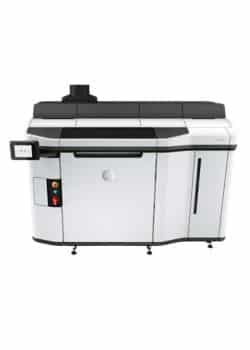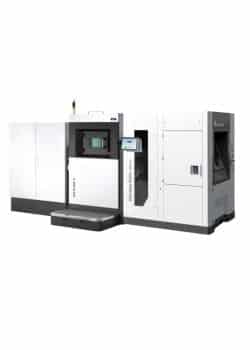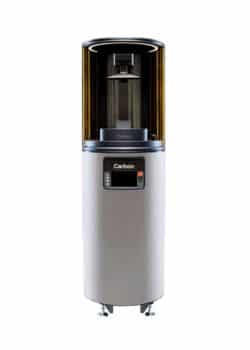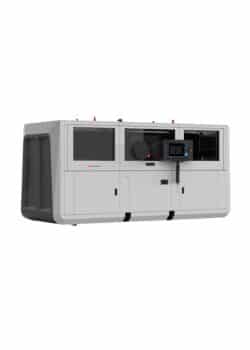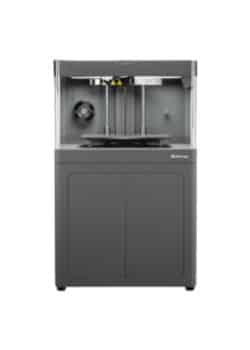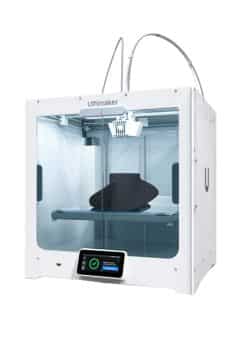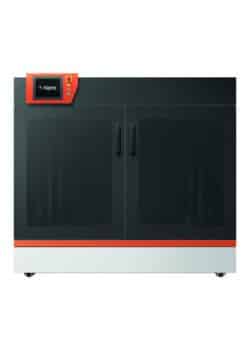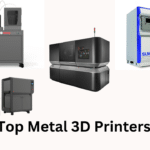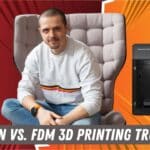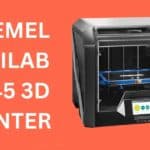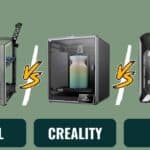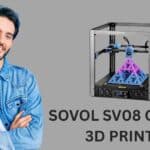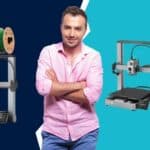
The Stratasys F900, HP Jet Fusion 5200, EOS M 400-4, and more lead industrial 3D printing—offering vast build volumes, high speed, and material versatility for manufacturing, from medical implants to automotive parts.
Industrial 3D printing is no longer a niche technology—it’s a cornerstone of modern manufacturing. From aerospace to healthcare, businesses are leveraging industrial 3D printers to produce complex parts, reduce costs, and accelerate production timelines. As we look ahead to 2025, the demand for industrial-grade 3D printers is expected to exceed around USD 24.03 billion by 2034, growing at a double-digit CAGR of 21.04% from 2024 to 2034, driven by advancements in materials, software, and hardware.
Affiliate Disclosure
We participate in Amazon affiliate programs, earning fees from qualifying purchases via links at no extra cost to you. It’s how we keep this blog rolling and my 3D printers buzzing with fresh filament for reviews like this one!
In this comprehensive guide, we’ll explore the 10 best industrial 3D printers in 2025 that are set to dominate large-scale manufacturing in 2025. We’ll dive deep into their key features, pros, cons, and real-world applications to help you decide which machine is the best fit for your business. Whether you’re producing metal components for aerospace or custom medical devices, these printers offer the precision, speed, and reliability you need to stay competitive.
Related: The Raise3D Pro2 Plus 3D Printer: An Honest, In-Depth Review for Pros and Makers
Why Industrial 3D Printing is the Future of Manufacturing
Before we dive into the list, let’s take a moment to understand why industrial 3D printing is such a game-changer.
1. Cost Efficiency
Traditional manufacturing often involves significant material waste. With 3D printing, you only use the material you need, reducing costs and waste. This is especially beneficial for industries like aerospace, where material costs are high.
2. Customization
Need a part with a unique design? 3D printing makes it easy to produce highly customized components without the need for expensive tooling. This is a game-changer for industries like healthcare, where patient-specific implants and prosthetics are in demand.
3. Speed
From prototyping to production, 3D printing accelerates timelines, allowing businesses to bring products to market faster. This is particularly valuable in industries like automotive, where time-to-market is critical.
4. Sustainability
Many 3D printing processes use eco-friendly materials and generate less waste, making them a greener alternative to traditional methods. This aligns with the growing demand for sustainable manufacturing practices.
Now, let’s explore the top 10 industrial 3D printers that are shaping the future of manufacturing.
Related: Best 3D Printers for Home Use (2025 Edition)
10 Best Industrial 3D Printers in 2025
1. Stratasys F900
The Stratasys F900 is a powerhouse in the world of industrial 3D printing. Designed for large-scale manufacturing, this printer is built to handle the most demanding production environments.
- Key Features:
- Massive Build Volume: 914 x 610 x 914 mm (36 x 24 x 36 in.), making it ideal for large parts.
- Wide Material Compatibility: Supports 15 production-grade thermoplastics, including ULTEM 9085, ABS-M30, and Nylon 12CF.
- High Precision: Layer thickness options range from 0.005 to 0.020 inches for fine details and smooth finishes.
- Reliability: Built for repeatability and durability, ensuring consistent performance over time.
- Pros:
- Large Build Size: Perfect for producing big parts in a single print.
- Material Versatility: Compatible with a wide range of high-performance materials.
- Industrial-Grade Durability: Designed for demanding manufacturing environments.
- Ease of Use: Intuitive software (GrabCAD Print) simplifies the printing process.
- Cons:
- High Initial Cost: The Stratasys F900 is a significant investment.
- Maintenance Requirements: Regular upkeep is necessary to maintain optimal performance.
- Space Requirements: Its large size may not fit in smaller facilities.
- Real-World Use:
- Aerospace: Producing large, complex components like ducting and tooling.
- Automotive: Manufacturing durable parts such as jigs, fixtures, and prototypes.
- Healthcare: Creating custom medical devices and surgical tools.
2. HP Jet Fusion 5200 Series
The HP Jet Fusion 5200 Series is a game-changer for medium-volume production of functional parts. Its Multi Jet Fusion technology delivers high-speed, high-quality prints.
- Key Features:
- High-Speed Production: Prints a full build volume (380 x 284 x 380 mm) in just 9.5 hours.
- Material Options: Compatible with a variety of thermoplastics, including PA 11, PA 12, and TPU.
- Automation: Features like the HP Jet Fusion 3D Powder Handling Automation Solution reduce manual labor and increase efficiency.
- Consistent Quality: HP 3D Process Control ensures repeatable accuracy and reliability.
- Pros:
- Fast Printing Speeds: Ideal for high-volume production.
- Excellent Surface Finish: Produces parts with smooth, high-quality surfaces.
- Scalability: Suitable for both prototyping and end-use part production.
- Automation-Friendly: Reduces manual intervention, saving time and labor costs.
- Cons:
- Limited Material Options: Fewer material choices compared to other industrial printers.
- Expensive Consumables: Material costs can add up over time.
- Complex Setup: Requires a dedicated space and proper ventilation.
- Real-World Use:
- Automotive: Producing functional prototypes and end-use parts like brackets and housings.
- Consumer Goods: Manufacturing durable products such as sports equipment and buckles.
- Healthcare: Creating prosthetics and medical devices with high flexibility and impact resistance.
3. EOS M 400-4
The EOS M 400-4 is a powerhouse in metal 3D printing, designed for ultra-fast, high-productivity industrial applications.
- Key Features:
- Four 400-Watt Lasers: Delivers up to four times higher productivity compared to single-laser systems.
- Large Build Volume: 400 x 400 x 400 mm (15.7 x 15.7 x 15.7 in.), ideal for large parts.
- Material Versatility: Supports a broad portfolio of materials, including aluminum, titanium, stainless steel, and superalloys.
- Automation-Friendly: Features an intuitive user interface and flexible software tools for seamless integration into industrial workflows.
- Pros:
- Ultra-Fast Production: Four lasers working simultaneously significantly reduce print times.
- High Precision: Focus diameter of 90 µm ensures fine details and smooth finishes.
- Scalability: Suitable for both prototyping and large-scale production.
- Material Compatibility: Works with a wide range of high-performance metals.
- Cons:
- High Initial Cost: A significant investment for businesses.
- Space Requirements: Requires a large installation space (min. 7500 x 6000 x 3300 mm).
- Complex Maintenance: Regular upkeep is necessary to maintain optimal performance.
- Real-World Use:
- Aerospace: Producing turbine blades and other high-performance components.
- Automotive: Manufacturing lightweight, durable parts for vehicles.
- Healthcare: Creating custom implants and surgical tools with biocompatible materials.
4. Carbon M2 Series
The Carbon M2 is a versatile 3D printer that scales from prototyping to mass production, offering speed, accuracy, and reliability.
- Key Features:
- Digital Light Synthesis (DLS): Combines speed and precision for high-quality parts.
- Medium Build Volume: 189 x 118 x 326 mm (7.4 x 4.6 x 12.8 in.), suitable for smaller, intricate parts.
- Material Options: Compatible with a wide range of resins, including durable, flexible, and biocompatible materials.
- Smart Part Washer: Automates post-processing, reducing labor costs and improving part quality..
- Pros:
- Fast Production: Optimized print speeds for rapid prototyping and production.
- High Resolution: XY resolution of 75 µm and Z resolution options of 25, 50, or 100 µm.
- Ease of Use: Intuitive software and automated workflows simplify operation.
- Scalability: Ideal for both small-batch and medium-volume production.
- Cons:
- Limited Build Volume: Smaller build size compared to other industrial printers.
- Material Costs: Resins can be expensive, especially for high-volume production.
- Post-Processing: Requires additional equipment like the Smart Part Washer for optimal results.
- Real-World Use:
- Consumer Goods: Producing durable products like shoe midsoles and eyewear.
- Healthcare: Manufacturing custom prosthetics, dental devices, and surgical tools.
- Automotive: Creating functional prototypes and end-use parts like brackets and housings.
5. 3D Systems Figure 4
The 3D Systems Figure 4 is a versatile and scalable 3D printing solution designed for both prototyping and direct digital production.
- Key Features:
- High-Speed Printing: Ultra-fast print speeds enable same-day prototyping and low-volume production.
- Modular Design: Scalable from standalone units to fully automated factory solutions.
- Material Versatility: Supports a wide range of engineering-grade materials, including rigid, flexible, and biocompatible options.
- Advanced Software: Includes 3D Sprint for file preparation and 3D Connect for fleet monitoring and remote diagnostics.
- Pros:
- Fast Production: Ideal for rapid prototyping and low-volume production.
- Scalability: Modular design allows for easy expansion as production needs grow.
- Material Options: Wide range of materials for diverse applications.
- Ease of Use: Intuitive software simplifies the printing process.
- Cons:
- Limited Build Volume: Smaller build size compared to other industrial printers.
- Material Costs: Engineering-grade materials can be expensive.
- Complex Setup: Requires additional equipment for fully automated solutions.
- Real-World Use:
- Prototyping: Rapid production of functional prototypes for testing.
- Healthcare: Manufacturing custom medical devices and surgical tools.
- Consumer Goods: Producing durable products like eyewear and footwear.
6. Desktop Metal Production System
The Desktop Metal Production System is a high-speed metal 3D printing solution designed for mass production.
- Key Features:
- Single Pass Jetting (SPJ): Achieves speeds up to 100 times faster than laser powder bed fusion technologies.
- Large Build Volume: Capable of producing tens of thousands of parts per day.
- Material Compatibility: Supports a wide range of metals, including stainless steel, reactive metals, and high-performance alloys.
- Inert Environment: Ensures consistent powder quality and part uniformity.
- Pros:
- High-Speed Production: Ideal for high-volume, end-use applications.
- Material Versatility: Compatible with a wide range of metals.
- Cost-Effective: Uses low-cost metal injection molding (MIM) powders.
- Reliability: Patented anti-ballistics technology ensures consistent print quality.
- Cons:
- High Initial Cost: Significant investment for businesses.
- Space Requirements: Requires a large installation space.
- Complex Maintenance: Regular upkeep is necessary to maintain optimal performance.
- Real-World Use:
- Automotive: Manufacturing lightweight, durable parts for vehicles.
- Aerospace: Producing high-performance components for aircraft.
- Healthcare: Creating custom implants and surgical tools with biocompatible materials.
7. Markforged X7
The Markforged X7 is a turnkey industrial 3D printer designed for producing high-strength, functional parts reinforced with continuous carbon fiber.
- Key Features:
- Continuous Carbon Fiber Reinforcement: Produces parts as strong as machined aluminum.
- Wide Material Compatibility: Supports materials like Onyx, Nylon, Carbon Fiber, Fiberglass, and Kevlar.
- Precision and Reliability: Features micron-level laser scanning for closed-loop calibration, ensuring 50 μm repeatability and industry-leading surface finish.
- Ease of Use: Cloud-based Eiger software simplifies the printing process.
- Pros:
- High-Strength Parts: Ideal for replacing metal components with lightweight, durable alternatives.
- Material Versatility: Suitable for flame-resistant, chemical-resistant, and energy-absorbent applications.
- Precision: Delivers consistent, high-quality prints with excellent surface finish.
- Scalability: Perfect for both prototyping and low-volume production.
- Cons:
- Limited Build Volume: 330 x 270 x 200 mm (13.0 x 10.6 x 7.9 in.) may not suffice for very large parts.
- Material Costs: Continuous carbon fiber and other advanced materials can be expensive.
- Software Dependency: Requires an internet connection for cloud-based Eiger software.
- Real-World Use:
- Aerospace: Producing lightweight, high-strength components for aircraft.
- Automotive: Manufacturing durable parts like brackets and fixtures.
- Industrial Tools: Creating custom jigs, fixtures, and tooling.
8. Ultimaker S5 Pro Bundle
The Ultimaker S5 Pro Bundle is a comprehensive 3D printing solution designed for professional use, offering advanced material handling, air filtration, and seamless workflows.
- Key Features:
- Dual Extrusion: Supports two materials simultaneously, ideal for multi-material prints and soluble supports.
- Material Station: Automates material management with a 6-spool feeder and humidity control.
- Air Manager: Filters 95% of ultrafine particles, ensuring a safe and consistent printing environment.
- Large Build Volume: 330 x 240 x 300 mm (13 x 9.5 x 11.8 in.) for expansive projects.
- Pros:
- Automation: Reduces manual intervention with automated material switching and humidity control.
- Material Versatility: Compatible with a wide range of materials, including PLA, ABS, Nylon, and carbon fiber-reinforced filaments.
- User-Friendly: Intuitive touchscreen interface and Ultimaker Cura software simplify operation.
- Reliability: Hardened components ensure durability, even with abrasive materials.
- Cons:
- High Initial Cost: The Pro Bundle is a significant investment.
- Space Requirements: The Material Station and Air Manager add to the printer’s footprint.
- Maintenance: Regular upkeep is required to maintain optimal performance.
- Real-World Use:
- Prototyping: Rapid production of functional prototypes for testing.
- Manufacturing: Creating end-use parts with advanced mechanical properties.
- Architecture: Producing large-scale models and context models.
9. Formlabs Fuse 1+ 30
The Formlabs Fuse 1+ 30W is an affordable yet powerful SLS (Selective Laser Sintering) 3D printer designed for high-performance parts.
- Key Features:
- Compact Design: Build volume of 165 x 165 x 300 mm (6.5 x 6.5 x 11.8 in.).
- High-Speed Printing: Prints up to 2x faster than its predecessor, thanks to a 30-Watt laser.
- Material Efficiency: Up to 70% powder recyclability, reducing waste and cost per part.
- Ease of Use: Intuitive touchscreen interface and cloud-based monitoring.
- Pros:
- Affordable SLS Option: A cost-effective entry point into industrial SLS printing.
- High-Quality Parts: Produces strong, durable parts with excellent surface finish.
- Powder Efficiency: Optimized powder recycling reduces material waste.
- User-Friendly: Easy setup and operation, even for beginners.
- Cons:
- Limited Build Volume: Smaller build size compared to other industrial printers.
- Slower Cooling Times: Requires 1-2 hours for cooling between prints.
- Material Limitations: Fewer material options compared to FDM or MJF printers.
- Real-World Use:
- Prototyping: Rapid production of functional prototypes for testing.
- Small-Batch Manufacturing: Ideal for low-volume production of end-use parts.
- Medical: Creating custom prosthetics and surgical tools with high precision.
10. BigRep PRO
The BigRep PRO is a high-performance industrial 3D printer designed for large-scale manufacturing, offering a massive build volume and advanced features for producing functional prototypes, tooling, and end-use parts.
- Key Features:
- Massive Build Volume: 1020 x 970 x 985 mm (40 x 38 x 38.5 in.), ideal for full-scale parts.
- Precision Motions Portal: Custom-built gantry with Bosch Rexroth CNC components for high-speed, vibration-free printing.
- Advanced Capability Extruder (ACE): Fiber-ready extruder for printing carbon fiber-reinforced materials 50% faster.
- JUMPSTART Workflow: Includes SWITCHPLATE® for easy bed adhesion, MXT® Control System for automatic calibration, and LOCKSTAGE for secure extruder mounting.
- Material Versatility: Supports engineering-grade materials like HI-TEMP, PETG, ASA, PA6/66, PA12 CF, and water-soluble BVOH.
- Airtight Filament Chamber: Sealed, temperature-controlled storage for consistent material quality.
- Pros:
- Large-Scale Production: Perfect for producing full-scale parts in a single print.
- High Precision and Speed: Delivers fast, accurate prints with minimal vibration.
- Material Flexibility: Compatible with a wide range of engineering-grade and fiber-reinforced materials.
- Ease of Use: JUMPSTART simplifies setup and calibration, making it user-friendly.
- Cost Efficiency: Reduces production costs by enabling in-house manufacturing of large parts and tooling.
- Cons:
- High Initial Cost: A significant investment, making it more suitable for established businesses.
- Space Requirements: Requires a dedicated workspace due to its large size.
- Material Costs: Engineering-grade and fiber-reinforced materials can be expensive.
- Learning Curve: Advanced features may require training for optimal use.
- Real-World Use:
- Prototyping: Rapid production of full-scale functional prototypes for testing and iteration.
- Tooling and Fixtures: Custom jigs, fixtures, and tools with reduced lead times and costs.
- Patterns and Molds: Cost-effective alternatives to traditional molds for faster production.
- End-Use Parts: Small-series production of unique parts without added costs, reducing inventory and warehousing expenses.
Related: The Best Filament Dryers for 3D Printing: Top 8 Picks
Comparison Table: Top 10 Industrial 3D Printers for Large-Scale Manufacturing in 2025
| Printer | Technology | Build Volume (mm) | Materials | Speed | Price Range (USD) | Key Applications |
|---|---|---|---|---|---|---|
| Stratasys F900 | FDM | 914 x 610 x 914 | ULTEM 9085, ABS-M30, Nylon 12CF, 15+ thermoplastics | Moderate (0.005–0.020 in layers) | ~$250,000+ | Aerospace (ducting), automotive (jigs), healthcare (devices) |
| HP Jet Fusion 5200 | Multi Jet Fusion (MJF) | 380 x 284 x 380 | PA 11, PA 12, TPU, glass-filled nylon | Fast (9.5 hrs/build) | $200,000–$300,000 | Automotive (brackets), consumer goods, healthcare (prosthetics) |
| EOS M 400-4 | DMLS (Metal) | 400 x 400 x 400 | Aluminum, titanium, stainless steel, superalloys | Ultra-fast (4x 400W lasers) | $500,000+ | Aerospace (turbine blades), automotive, healthcare (implants) |
| Carbon M2 Series | Digital Light Synthesis (DLS) | 189 x 118 x 326 | Resins (durable, flexible, biocompatible) | Fast (prototyping) | $100,000–$150,000 | Consumer goods (midsoles), healthcare (dental), automotive |
| 3D Systems Figure 4 | DLP | 124.8 x 70.2 x 346 | Rigid, flexible, biocompatible resins | Ultra-fast (same-day) | $50,000–$100,000 | Prototyping, healthcare (devices), consumer goods (eyewear) |
| Desktop Metal Production System | Single Pass Jetting (SPJ) | Varies (high throughput) | Stainless steel, reactive metals, alloys | Up to 100x faster | $500,000+ | Automotive, aerospace, healthcare (implants) |
| Markforged X7 | FDM + Continuous Fiber | 330 x 270 x 200 | Onyx, Nylon, Carbon Fiber, Kevlar | Moderate (50 μm) | $77,990 | Aerospace (components), automotive (fixtures), industrial tools |
| Ultimaker S5 Pro Bundle | FDM | 330 x 240 x 300 | PLA, ABS, Nylon, carbon-reinforced | Moderate (dual extrusion) | $10,000–$15,000 | Prototyping, manufacturing (parts), architecture (models) |
| Formlabs Fuse 1+ 30W | SLS | 165 x 165 x 300 | Nylon 12, Nylon 11, Nylon 11 CF | Fast (2x faster) | $20,000–$30,000 | Prototyping, small-batch manufacturing, medical (prosthetics) |
| BigRep PRO | FDM | 1020 x 970 x 985 | HI-TEMP, PETG, ASA, PA6/66, PA12 CF | Fast (fiber-ready) | $60,000–$100,000 | Prototyping, tooling, molds, end-use parts |
How to Choose the Right Industrial 3D Printer for Your Needs
Choosing the right industrial 3D printer can feel overwhelming, but it doesn’t have to be. Here are some tips to help you make the best decision:
- Identify Your Needs: Are you producing large parts, small components, or something in between?
- Consider Materials: Make sure the printer supports the materials you need for your applications.
- Evaluate Speed and Precision: Balance production speed with the level of detail and accuracy required.
- Think Long-Term: Consider the total cost of ownership, including maintenance and material costs.
- Test Before You Buy: If possible, request a demo or sample print to see the printer in action.
The Future of Industrial 3D Printing in 2025
As we approach 2025, industrial 3D printing will continue to evolve. Expect to see advancements in multi-material printing, AI-driven optimization, and sustainable manufacturing. Businesses that adopt these technologies early will gain a competitive edge, unlocking new possibilities for innovation and growth.
Final Thoughts
The ten printers highlighted here—from the Stratasys F900 to the BigRep PRO—represent the pinnacle of innovation, each excelling in distinct niches to meet the demands of modern production.
For large-scale manufacturing, the Stratasys F900 and BigRep PRO stand out, offering expansive build volumes and robust reliability. Speed seekers will gravitate toward the HP Jet Fusion 5200 Series and 3D Systems Figure 4, which prioritize rapid prototyping and medium-volume production without sacrificing quality. Meanwhile, metal enthusiasts can rely on the EOS M 400-4 and Desktop Metal Production System for ultra-fast, high-precision prints in aerospace and automotive applications.
Material versatility shines in models like the Carbon M2 and Markforged X7, which cater to specialized needs—from biocompatible medical devices to carbon fiber-reinforced industrial tools. For those balancing affordability with advanced capabilities, the Formlabs Fuse 1+ 30W and Ultimaker S5 Pro Bundle offer scalable solutions for small-batch production and multi-material workflows.
Key considerations remain universal: cost, build volume, material compatibility, and post-processing demands. While high initial investments and maintenance are common trade-offs, the ROI in efficiency and customization is undeniable.
As industries push toward smarter, faster, and more sustainable manufacturing, these printers are not just tools—they’re catalysts for innovation. Whether crafting life-saving medical implants or revolutionizing automotive supply chains, the right 3D printer transforms vision into reality. Choose wisely, and let 2025’s technology propel your ambitions into the future.
Related: 10 Best 3D Printers in 2025 (All Budgets)
Frequently Asked Questions (FAQs)
What is the best industrial 3D printer for metal manufacturing?
For metal manufacturing, the EOS M 400-4 stands out with its four 400-watt lasers and 400x400x400mm build volume, delivering ultra-fast production and high precision for aerospace and automotive parts. It supports materials like titanium, stainless steel, and superalloys, making it ideal for turbine blades and implants. Alternatively, the Desktop Metal Production System offers high-speed single-pass jetting for cost-effective mass production.
How much does an industrial 3D printer cost in 2025?
Industrial 3D printer prices vary widely:
Stratasys F900: ~$250,000+ (quote-based).
HP Jet Fusion 5200: ~$200,000–$300,000.
Formlabs Fuse 1+ 30W: ~$20,000–$30,000, the most affordable SLS option. Costs depend on build volume, materials, and automation features. Contact manufacturers for precise quotes.
Can industrial 3D printers handle high-volume production?
Yes! Printers like the HP Jet Fusion 5200 and Desktop Metal Production System are designed for medium- to high-volume production, with fast print speeds (e.g., 9.5 hours for a full build) and automation features to minimize labor. The BigRep PRO excels for large-scale, low-volume production of full-scale parts like tooling and molds.
What materials are compatible with the Stratasys F900?
The Stratasys F900 supports 15 production-grade thermoplastics, including:
ULTEM 9085: High-strength, flame-retardant for aerospace.
ABS-M30: Durable for automotive prototypes.
Nylon 12CF: Carbon fiber-reinforced for lightweight, strong parts. This versatility makes it perfect for manufacturing jigs, fixtures, and end-use parts.
Are industrial 3D printers sustainable for manufacturing?
Industrial 3D printing promotes sustainability by reducing material waste (up to 70% powder recyclability with the Formlabs Fuse 1+ 30W) and enabling eco-friendly materials like recycled polymers (supported by HP Jet Fusion 5200). These printers align with 2025’s push for greener manufacturing practices.


